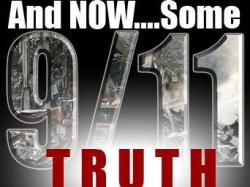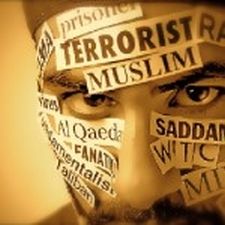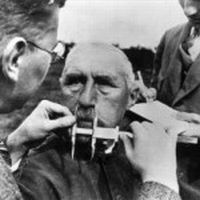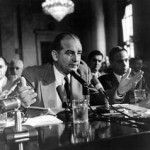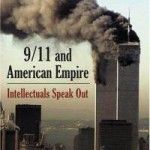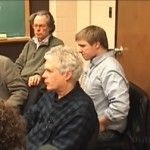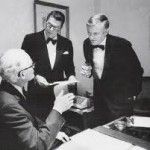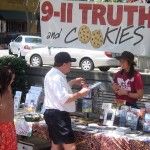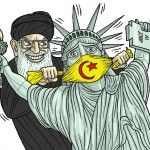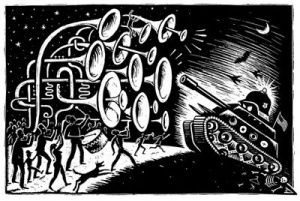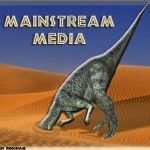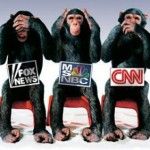Document:Waging the Battle for Reality
Source: Salem News
On a Propagandist’s Journey in Search of his so-called Conspiracist Underground.
★ Start a Discussion about this document
Contents
- 1 Waging The Battle for Reality
- 1.1 From Enemy Aliens to Underground Conspiracists
- 1.2 Attacking the Messengers
- 1.3 Jonathan Kay’s Paranoid Style of Political Journalism
- 1.4 Savagery and Civilization in the Middle East?
- 1.5 De-Torquing the Media Spin of Those Who Would Slay the Dragons of Conspiracism, Conspiracists and Conspiracy Theories
- 1.6 Endnotes for “Jonathan Kay’s Defense of the Sacred Myth of 9/11”
Waging The Battle for Reality
Jonathan Kay’s book Among the Truthers was written to coincide with the tenth anniversary of the contested events of 9/11. Its contents vividly illustrate the strategic geopolitical importance of the public’s changing perception of the hit on the Pentagon and the pulverization of the three World Trade Centers on September 11, 2001.
Most of Kay’s core arguments in the text are undermined by the author’s self-confessed decision not to address directly the empirically-verifiable proof pertaining to what did or did not happen on 9/11. Kay’s zeal to avert any hard reckoning with the complex body of evidence underlying his radical conclusions helps to shed light on the culture of cover-up and propaganda necessary to keep the sacred myth of 9/11 alive in the public’s imagination.
One of the biggest lies of 9/11 involves the all-purpose boogeyman known as al Qaeda. The claim is often advanced either explicitly or implicitly that this caricatured embodiment of Islamic evil somehow extricated itself from the CIA and the other related agencies that founded the anti-communist proxy army of Islamic jihadists who, with US backing in the 1980s, overturned the Soviet-backed puppet regime in Afghanistan. Kay simply goes along with the prevalent public mythology constructed to present al Qaeda as a credible replacement for the now-defunct Soviet enemy in order to justify the further expansion, empowerment and privatization of the world’s most formidable and expensive military-industrial complex.
A very detailed interpretation of al Qaeda as the primary villain of 9/11 was fed into the echo chambers of the mainstream media from the first hours following the attacks until the present day. This interpretation has had the predictable outcome of driving a wedge between Islam and those adhering to a narrowed construction of the so-called West.
The sacred myth of 9/11 depends on planting diabolical stereotypes of Islamic terrorists in popular imagination. It injects new impulses of distrust between the worldwide ummah of Muslims and those encouraged to situate their heritage within the Judeo-Christian stream of history.
This development helps block wider appreciation in Europe and North America of the historic and continuing importance of Islam in the genesis of Western civilization, global civilization. The sacred myth of 9/11 helps renew the old imperial ploy of divide and conquer. By highlighting issues of religion and ethnicity as the primary cause of, and justification for, global conflict, the sacred myth of 9/11 diverts attention away from the huge and growing gap between rich and poor.
The sacred myth of 9/11 helps to raise walls of separation that hold back the wretched of the earth from the riches of capitalism’s blood-diamond elite. It is the vast disparities of material entitlement, not some engineered and trumped-up conflict of civilizations, that requires our most urgent attention. The perpetuation of the sacred myth of 9/11 helps divert attention from places where it is really needed such as post-Fukushima Japan.[1]
The enshrinement of 9/11 as a sacred myth was founded on the broadly-publicized religious iconography of martyred civilians slaughtered in a terrible inferno brought about through the stealth of ruthless Islamic jihadists. The Bush White House took the lead in integrating this religious interpretation of 9/11 into a twenty-first century version of American Manifest Destiny.[2] Only three days after the attacks the US President, George W. Bush, declared war at the Episcopal National Church in Washington DC.
In his sermon from the pulpit, President Bush sanctified the sacred myth of 9/11 as follows: “Our unity,” the US president intoned, “is a kinship of grief and a steadfast resolve to prevail against our enemies. And this unity against terror is spreading across the world… Our responsibility to history is already clear: to answer these attacks and rid the world of evil. War has been waged against us by stealth, and deceit and murder. This nation is peaceful but fierce when stirred to anger…. In every generation the world has produced enemies of human freedom. They have attacked America because we are freedom’s home and defender, and the commitment of out Fathers is now the calling of our time.”[3]
The sacred myth of 9/11 is based on a government conspiracy theory that Muslim terrorists, acting alone, succeeded in hijacking passenger airliners and then flying these large planes into big and important buildings. This explanation of the hit on the Pentagon and the pulverization of the three World Trade Center Towers in New York, however, has never been proven in any credible court of law. Many who should be leading the call for credible, third-party adjudication on matters of guilt or innocence in this extremely serious and complex criminal matter have averted their gaze from the lies and crimes of 9/11 with an eye to political and careerist expedience.
As long as the sacred myth of 9/11 has been allowed to prevail, there have been few legal consequences for those in government and in the media who failed in their responsibility to do due diligence in investigating the 9/11 crimes. That failure continues in the mainstream media’s ongoing unwillingness, with some few exceptions, to report in a fair and balanced way on the activities of the citizens’ investigation of 9/11, but especially on the published findings of its leading investigator, Professor David Ray Griffin.
The status quo, however, is not indefinitely sustainable. Little by little flashes of rationalism have subjected the dark superstitions permeating the public mythology of 9/11 to competing narratives. The imagery of 9/11 as the crucible of religious war is becoming increasingly difficult to sustain in light of a stream of startling revelations emerging from various parts of an unprecedented citizens’ investigation. This many-faceted citizens’ investigation is sometimes derided and sometimes celebrated as the animating force of the 9/11 Truth Movement.
This movement draws energy from the upsurge of popular disgust at the scale and scope of the lies and crimes that continue to be the métier of the national security state that was ushered into formal existence in 1947 with the passage by the US Congress of the National Security Act. Throughout most of the period since the Second World War the national security state helped to fund, organize and promote many zealous Islamic theocrats as anti-communist allies of Cold War capitalism. Like so many of their covert actions, the CIA took over this anti-Soviet strategy from Nazi agents of anti-communism.[4]
The mainstream media has been one of the key sites of the onslaught of criminal and unethical activities in which the national security state specializes. It was shown in the post-Watergate investigations of the 1970s, for instance, that all of the most important media outlets in North America hosted over 3000 paid agents of anti-communist disinformation hired by the CIA in Project Mockingbird.[5] No organization of professional journalists have ever dealt seriously with revelations that their industry is subject to deep subversion by agents of the national security state and other sponsors of propaganda paid to twist, distort, censor or obliterate truth in reporting.
Knowledge of the cloak-and-dagger history of the national security state has helped to inform the citizens’ investigation of 9/11. What really did or did not happen on 9/11? And why does it matter so much? The answer to the second question is that the continuing reign of lies required to protect the sanctity of the sacred myth of 9/11 is unusually outlandish. The unbroken onslaught of lies concerning 9/11 transcends the run-of-the-mill disinformation coming our way on a daily basis. The scale of the misrepresentations of what really happened on September 11, 2001 is simply so audacious, and the crimes enabled by the frauds so corrosive to the health and peace of the world, that extraordinary efforts of citizens’ mobilization and intervention are required. The real culprits must be identified, apprehended and brought to justice in an appropriate court where they will be afforded every opportunity to defend themselves. Only by continuing the quest for 9/11 truth is there any chance that the litany of international crimes at the core of the 9/11 Wars can be curtailed.
From Enemy Aliens to Underground Conspiracists
Enter Jonathan Kay. In his effort to prop up the increasingly discredited narrative of what happened on 9/11, namely that nineteen Saudi jihadists caught the entire military and intelligence apparatus of the United States completely by surprise, Kay resorts to many of the old tactics of media manipulation developed during the Cold War. He employs the whole arsenal of McCarthyesque clichés, where the so-called Truthers are made to stand in for stereotypical communist infiltrators seeking to subvert society from within.
By drawing on the language of eugenics and so-called “mental hygiene,” Kay depicts those that do not accept every detail of the officially-sanctioned myth of 9/11 as sources and carriers of an intellectual infection so menacing that society must be inoculated against this alleged heresy. Kay proposes as the key to his scheme of mental inoculation the introduction in the classroom of education designed to teach students to recognize and avoid the mental disease of “conspiracism.” In pushing this line, Kay goes much farther than even some of the more aggressive propagandists of Cold War anti-communism. By engaging in such rhetorical excesses to smear his opponents, Jonathan Kay raises the ante in what he refers to in an earlier draft of his lavishly-funded research project as “the battle for reality.”
Kay presents himself as a friend and proponent of the Enlightenment’s heritage of rationalism. But the author then proceeds to trash this vital legacy. By his own admission, Kay violates the rules of scholarly proof and proper citation. He fails to deal in a rigorous way with the existing evidence pertaining to what did or did not happen on 9/11 as well as what did or not happen to make this event the pretext for aggressive wars, illegal occupations, and a many-faceted assault on civil liberties.
Accordingly, Kay fails dramatically to walk his talk by honestly addressing the very important assessments brought forward by some of the most authoritative critics of the deeply flawed official account of what happened on 9/11. Instead of delving into the alleged heresies thinker by thinker, book by book, article by article, even footnote by footnote, Kay opts to medicalize the whole matter. Without even a gloss of credentials in the field, Kay appoints himself as a practitioner his own school of social psychiatry. From this platform of quackery Kay diagnoses all those who do not share his worldview as victims of “collectively experienced mental illness.”
In Kay’s virulent verbiage he throws around generalizing terms like “Truther,” “Trutherdom” and “conspiracist” in much the same way that bigots of another area could safely deploy terms like nigger, wap, pinko, kike, papist or homo to stigmatize and dehumanize whole groups deemed unfit for full integration into polite society. Kay’s resort to the toxic terminology emerging from racist taxonomy shows up in his identification of “the different breeds of conspiracy theorist.” [6] In this fashion the good, bad or indifferent intellectual work of particular activists is not dealt with on its own merits or demerits. Instead, the power of stereotypes is invoked so that masses of individuals can be set up for indiscriminate smear and ridicule.
In Kay’s demonology, the so-called Truthers become the heirs of the enemy aliens once targeted for deportation by the US Justice Department during the Red Scare after the First World War. They are set up as domestic equivalents of the so-called unlawful enemy combatants. The category of unlawful enemy combatants is based on the creation of a legal fiction advanced by the US Executive branch in order to give cover to the uninterrupted orgy of illegal torture, arbitrary incarceration and extrajudicial murder done in the name of the sacred myth of 9/11. In Kay’s hit job, “typical specimens” of his invented syndromes of “conspiracist” dementia are said to offer examples of “incurable disease.” (315)
Kay’s book is one part of a series of initiatives aimed during the tenth anniversary of September 11, 2001 at pointing audiences away from the reality that many conscientious professionals have already demonstrated at risk to themselves and their careers that the evidence does not support the sacred myth of 9/11. The extremism displayed in Kay’s defense of the superstitions attending the officially-sanctioned conspiracy theory makes Among The Truthers a very significant work, one that will be remembered much like Joseph McCarthy’s anti-communist tirades are remembered today as telling snapshots illustrating a particularly extreme instance of America’s need to affirm its superiority through the demonization of others. The well-known propensity to define US identity through acts of physical and rhetorical combat with real, imagined or manufactured enemies is epitomized by Kay’s attempt to cast himself as a modern-day whistle blower calling attention to what he deems to be an upsurge in un-American and anti-Israeli activity.
Jonathan Kay's smearing of so-called "Truthers" as "conspiracists" plays on many of the same themes and techniques employed in the early 1950s by Senator Joseph McCarthy and his Congressional Committee on Un-American Activities
The single individual that has done the most to expose the many internal contradictions and inconsistencies in the government account of 9/11 is Professor David Ray Griffin.
Of Professor Griffin’s three dozen or so well regarded academic books, the last eleven deal with both big picture analysis and detailed assessment of the minutiae of what did or did not happen on 9/11.[7] Kay refuses to address the substance of Professor Griffin’s publications, which can be viewed as mandatory entry-level reading for anyone with an interest in getting up to speed on the academic literature of 9/11.
Instead of dealing with even one significant aspect of Professor Griffin’s oeuvre, the non-academic Kay simply writes off the publications of his chief nemesis as those of the “leading crank” of the 9/11 Truth movement. (193) Kay similarly dismisses the peer-reviewed scholarship of Professor Paul Zarembka and the investigative reporting of veteran Canadian journalist Barrie Zwicker as that of “Truther cranks.”(190)
Kay’s resort to name calling as a substitute for genuine engagement with the burgeoning literature of 9/11 Studies is reflected in his shoddy and unscholarly approach to documentation. Tellingly, Among the Truthers contains no footnotes or endnotes. On page 20, however, the author does include in the body of his text a single paragraph giving the precise titles of the handful of publications and web sites, including Screw Loose Change, that support his embattled side in a debate of pivotal geopolitical significance for the future prospects of war or peace on the planet.
By failing to cite systematically the publications of the targets of his hit job, Kay deprives his readers of the capacity easily to assess for themselves whether or not the author’s criticisms and caricatures are based on credible evidence. As a substitute for evidence Kay resorts to the kind of psychobabble developed by Michael Shermer, a TV performer who frequently impersonates a professor in the mainstream media. All that really backs Shermer’s personae as an academician is an ephemeral, part-time teaching position in the same community— Claremont California– where the tenured, prolific and full professor, David Ray Griffin, has spent the majority of his much-celebrated academic career.[8]
Michael Shermer Exposed Mischaracterizing
his Academic Credentials
The demeaning outcome of Kay’s effort to substitute name calling for engagement in the scholarly literature of 9/11 is most evident in chapter five. Here Kay extends his Shermeresque topography of alleged deviance to demean his opponents as examples of “the damaged survivor,” “the cosmic voyageur,” “the clinical conspiracist,” “the evangelical doomsayer,” “the firebrand,” and the author’s most all-purpose put down, “the crank.”
Kay reserves some of his most visceral expressions of contempt for those he slights for the alleged crime of being middle aged. “Many come to the crankerdom in middle age,” the author posits. (191) In this tawdry fashion Kay would sweep aside the significance of Richard Gage’s work. Gage is the founder and leading voice of the 1500 member strong Architects and Engineers for 9/11 Truth. Kay chooses to emphasize what he characterizes as Gage’s “midlife crisis” rather than deal with the reasons why Gage has been reaching wider and wider audiences with his frequent, well-attended and well-illustrated public presentations explaining the science of how the three World Trade Center Towers plunged through the course of maximum resistance into their own footprints at speeds near that of free fall.
Kay pontificates, “the children grow up, the hair falls out, careers plateau, physical powers ebb….. Like all forms of midlife crisis, the sudden lurch into conspiracism offers middle-aged men a sense of revitalization and adventure. In some ways it offers an even more complete escape than the proverbial mistress and sports car.” (159)
Kay offers an explanation of his preference for character assassination over genuine engagement with the writings and marshaled evidence of those he characterizes as deviants and enemies of the Enlightenment’s vital legacy of rationalism. Apparently the market made him do it. Near the end of his book Kay explains, “’Debunking books don’t sell, one New York City editor explained to me when I told him my original draft of Among the Truthers contained several long chapters explaining the logical fallacies within 9/11 Truth theories. ‘Conspiracy theorists won’t believe you. And normal people don’t need to be told what you’re telling them. So you have no audience’” (320)
Kay’s advisor sees the world as a place divided between supposedly “normal people” and those with the audacity to disagree with Kay’s characterization of reality. Kay’s discussion of his missing chapters entails a recognition that he has not dealt in Among the Truthers with the evidentiary basis underlying his sweeping and generalizing allegations. Kay could easily rectify his claimed removal of the debunking chapters by publishing them on the Internet. But do these missing documents really exist, or is the author being disingenuous?
Come clean please Mr. Kay. Let’s see if you can back up what you say you have done on the way to your book’s conclusions where you posit that there is no merit in anything written by a host of reputable scholars, journalists and technical experts. Many of those you dismiss, but particularly Professor Griffin and Barrie Zwicker, have careers that are much more distinguished than your own.
Like his supposed removal of chapters said to contain his engagement with the evidence, Kay is prone to disappear whatever does not conform to the sanctified religious myth of 9/11 that the author so evangelically embraces and disseminates. Kay is either unaware or unwilling to discuss some of the most important scholarship to illuminate the substance of a defining event in recent global history. He only refers tangentially, for instance, to one of the pioneers of 9/11 Studies, Professor Michel Chossudovsky, an economist at the University of Ottawa. Kay does not deal at all with the important 9/11 work of Professor Graeme MacQueen, the Harvard-educated scholar who is the founder of the Peace Studies program at McMaster University.
Kay also disappears from his survey of the so-called truthers, to mention only a few, Paul Craig Roberts, Ray McGovern, Yukihisa Fujita, Andreas Von Buelow, Splitting The Sky, Travis Ball, Kevin Pearson, Leonid Ivashov, Guillietto Chiesa, David Chandler, Anthony Lawson, Kevin Bracken, Mark Crispin Miller, Debora Blake, Kevin Ryan, Carol Brouillet, Adnan Zuberi, Cynthia McKinney, Susan Lindauer, Kristina Borjesson, Michael Pengue, Fran Shure, Gordon Duff, Diane Castillo, Elias Davidsson, Hamid Gul, Paul McArthur, Jeremy Rothe-Kushel, Richard Brinkman, and Bill Christison. The list could go on and on of those serious and accomplished figures that do not share Kay’s complete, unquestioning and unqualified embrace of the sacred myth of 9/11.
Attacking the Messengers
While Kay makes much of the advice of his editor friend who is said to have dissuaded him from debunking the sacred myth of 9/11, he also disappears from Among the Truthers any account of the author’s important editorial revelation published in October of 2008. In a surprising op ed column Kay acknowledged that he had persecuted and smeared in print a so-called 9/11 Truther without doing any research at all to back up his attack. He admitted that he could probably get away with continuing to lie to his readers by reassuring them he had read the relevant literature on 9/11. Kay continued, “But the truth is I haven’t… I never bothered with schooling myself on the minutiae of 9/11-ology… I never felt the need to because, on a purely instinctual level, I always felt the Truthers case was complete nonsense.”[9]
Was Kay genuinely humbling himself in making this admission that he depended on instinct rather than evidence in assessing the truth of what did or did not happen on 9/11? How many other public intellectuals who follow Kay’s lead base their position on 9/11 on instinct and a sense of what is expedient for their careers rather than on their own reading of the relevant scholarly literature? Was Kay lying in declaring his intention to investigate or was he simply planting a necessary cover story calculated to gain access to those he would interview with the preconceived object of depicting his subjects as bottom feeders in the so-called conspiracist underground?
Jonathan Kay + 911 Researchers
Dallas Hansen of Winnipeg and New York has presented his own assessment of the sincerity of Jonathan Kay’s declaration in the National Post that he was setting out to discover the truth about 9/11. Hansen describes Kay’s lazy and detached presence on the edges of the eighth-anniversary events in New York City on September 11 of 2009. After giving a detailed account of all the important speeches and interview possibilities Kay missed by preferring to stay holed up in his hotel room, Hansen addresses the editorialist as follows” You were never among the truthers— rather you acted as though their ideas were a contagion from which you could stay immune only as long as you stayed in your ivory tower.” Hansen completes his short account with a comment about Kay’s preference for Wendy’s bacon cheeseburgers over the food for thought that the author could have ingested had he opened his mind and come out of his self-imposed isolation. [10]
Although Kay makes a major point in his text of drawing the connections between the those who claim to have debunked the government’s account of the killing of John F. Kennedy and those who claim to have debunked the government’s account of the events of 9/11, Kay makes no reference whatsoever to the prolific scholarship of Berkeley Professor, Peter Dale Scott. Scott has written specifically about how his investigations into the “deep politics” of the Kennedy assassination have influenced his research methodology and mode of analysis in 9/11 Studies.[11] Like Professor Griffin, Professor Scott is one of the more celebrated stars of his home university.
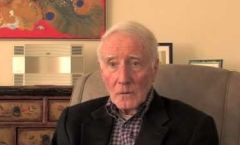
Professor Scott, who is now well into his 80s, began his career as a Canadian diplomat before he moved on to the English Department at the University of California at Berkeley. This son of Canada’s legendary civil libertarian, F.R. Scott, is far better known in the United States than in his native Canada. In ignoring Professor Scott’s scholarly contributions on 9/11 and many other topics, Kay has contributed to preventing broader recognition of the scholarly and poetic contributions of a very accomplished and erudite Canadian.
Kay mentions me twice in his text, once as “one of Canada’s most aggressive Truthers” (168) and once as the MA supervisor of Joshua Blakeney, the recipient of the Queen Elizabeth II Scholarship at the University of Lethbridge. (271) Just prior to his publishing Among the Truther Kay chose to make national news of Blakeney’s scholarship when he wrote an editorial disguised as a news story accusing my home school of bilking the tax payers of Alberta for helping to fund the graduate studies of a so-called “conspiracy theorist.” (271) Kay treats me the same as most of the other professors he attacks in neglecting to refer in any way to any of our publications on 9/11. The one of which I am most proud is Earth into Property: Colonization, Decolonization, and Capitalism. It is a big and ambitious book published in 2010 by McGill-Queen’s University Press.
While Earth into Property covers an expanse of topics far broader than 9/11, it does go into the historical precedents and outgrowths of the events of September 11, 2001. It also presents a history of the rise of the many-faceted international citizens’ movement engaged in the quest for the truth of what did or did not happen on 9/11. The fact is, my text is peer reviewed and Among the Truthers is not. The fact is, Earth into Property is published by Canada’s most prestigious university press whereas Kay’s text is published by a subsidiary of the company responsible for Fox News, Glenn Beck’s ranting and wall-to-wall coverage of the Tea Party in the United States.
I make these comparisons with an eye on the sentence following Kay’s ridiculing of those professors who appear on You Tube, which I do fairly often thanks in large measure to the technical and creative prowess of Joshua Blakeney. Just because Mr. Blakeney and I use the New Media of digital communications to disseminate some of our theories and interpretations does not prove an aversion to, in Kay’s own words, “having to go through the lengthy, frustrating process of peer review.” (192)
Earth into Property
As far as I know Jonathan Kay has never written a peer reviewed article or book. Kay has no Ph.D. and has never held an academic position in a university. His university education is in metallurgy and law, specialties that he does not draw upon in any systematic way in authoring Among the Truthers. In spite of his decision to became an editorial writer rather than a scholar, Kay deputizes himself as qualified to dismiss as the stuff of “crankerdom” significant academic texts written by professors who have flourished in their careers by going through all the requirements of peer-reviewed publication, assessments of teaching, tenure, and promotion.
This is not to say that everything written or broadcast in the quest for 9/11 truth is uniformly sound and meritorious. Even members of the professorial contingent of the so-called 9/11 truth movement are not in every instance on solid evidentiary ground in every detail of their work. Moreover, it cannot be denied that there are some wild and unsupported and even anti-Jewish, anti-Jesuit, or anti-UN theories about who did 9/11 if the 19 Saudis with box cutters did not. As long as those public officials with a responsibility to provide the public with a credible, evidence-based explanation of the anomalies of 9/11 continue to fail in doing due diligence, however, speculation about what really happened will continue to abound.
While the jury is still out on who really did 9/11, the citizens’ investigation of the crime has already proven beyond any reasonable doubt that the debacle did not happen in the way we have been told since the early hours of the post-9/11 era. The towering figure in proving that the official explanation of 9/11 is inconsistent with the available evidence, however imperfect and incomplete, is Professor David Ray Griffin. Professor Griffin is indisputably the first and foremost among those of us in the academy who have chosen to make a specialty of 9/11 Studies. Moreover, the academic analysis of, among others, Professor Steven E. Jones formerly of Brigham Young University and the University of Copenhagen’s Niels Harrit, has made it absolutely clear that World Trade Center 7, although not hit by any airplane, plunged to the ground in the flash of a few seconds late in the afternoon of 9/11 due to controlled demolition.
'Veterans Today' videos
9-11 and Afghanistan
David Ray Griffin - 9 August 2009
Rumsfeld on bin Laden's Caves
Kay seems to criticize professors Griffin and Zarembka as well as Barrie Zwicker for being “curiously detached from the profoundly disturbing implications” that flow from the disentanglement of truth from fiction on the 9/11 file. (190) Clear Kay could not see beneath the surface. There can be no detachment from the heavy weight of responsibility that arises for those on the cutting edge of research and publication in the citizens’ investigation of 9/11. There are huge implications that arise from the disparity between the sacred myth of 9/11 and what the evidence tells us. In our shared societal efforts to address this grave matter, only the truth shall set us free. As the extreme and bombastic content of Among the Truthers attests, this quest for 9/11 truth is already proving inconvenient to the interests of those entrenched in the centers of power that give Mr. Kay his place at the table of daily public discourse.
The alternative to our reckoning with the hard truths of 9/11 is endless war and our uncritical submission to a degrading and false picture of reality based not on proven fact but on lies and superstitions convenient to power. Thus a return to the vital heritage of Enlightenment rationality, which I embrace and celebrate even as Jonathan Kay claims the same, points in the direction scouted through the tireless scholarly labors of David Ray Griffin. Similarly, it points away from the dark superstitions epitomized by the politics of Dick Cheney in his efforts in the Bush White House to broaden the reach of the national security state, but especially the for-profit and increasingly privatized components of its attending military-industrial complex.
This imperial establishment directing the national security state and the military-industrial complex has thrived at the core of America’s political economy ever since the inception in 1941 of the permanent war economy adopted by the United States after the Japanese attack on Pearl Harbor. The elaborate government and corporate machinery of Cold War anti-communism was destined for obsolescence if al-Qaeda had not been made to come along in the wake of the Soviet Union’s demise. A global enemy was needed to justify the continuation of the military Keynesianism that has diverted the riches of the United States away from needed expenditures in health, education, basic infrastructure and social security for average American citizens. On 9/11 that necessary global enemy was made to appear just in time to reenergize the corrupt cabal of war profiteers that benefit enormously from the military Keynesianism of the United States.
The contents of Kay’s book form one small part of the elaborate process of trying to prevent the consolidation of conditions that might elevate the prospects of peace over the imperatives war and all the profits to be derived from the proliferation of state lawlessness, violence, distortion and lies. Thus the quest for the truth of what really happened on 9/11 is the necessary requirement for changing course back towards the light and away from the darkness propounded by the likes of Jonathan Kay with his warnings about a “growing conspiracist underground.”
Indeed, Kay’s literary invention of the subterranean place where the so-called Truthers are said to congregate is suspiciously akin to imagery of the dark caves where, we were told in the first hours following the attacks of 9/11, Osama bin Laden and his band of jihadists supposedly planned the attacks on the prime symbols of American commercial, military and political prowess.
Jonathan Kay’s Paranoid Style of Political Journalism
In his book-length hit piece editorialist Jonathan Kay has fashioned a text that epitomizes the intensification of the paranoid style of American politics in the twenty-first century. In his literary effort to demean, demonize and smear those with whom he disagrees, Kay cites the famous essay by Richard Hofstadter to buttress his assertions.
An astute academic observer of both the intellectual and anti-intellectual history of the United States, Hofstadter’s frequently republished essay first appeared in 1964 as a response to the rise of Barry Goldwater to the leadership of the Republican Party. The ascent of Ronald Reagan’s hero and role model to leadership of the Republican Party helped usher in an era of reenergized imperial ambitions in the United States. One recent demonstration of the pivotal character of Barry Goldwater’s political career showed up in May of 2011, when the Bushite government of Prime Minister Stephen Harper finally obtained an electoral majority in the Canadian House of Commons.
The ascent of Harper to Canada’s top job is closely tied up with the history of Kay’s employer, the National Post. In the days before the controversial press baron was criminalized and incarcerated, Conrad Black hired Jonathan Kay in the process of pointing the Post towards the right-wing extremes of political discourse in the late 1990s. The National Post has been an integral part of the process of replacing with an imported style of US conservatism the indigenous style of Canadian Toryism inherited from the British Empire’s resistance to the American Revolution. Hence it is hardly surprising that Kay’s new book, one that follows his co-authorship with Michael Ross of a text presenting a flattering account of the activities of a Canadian Mossad agent,[12] should be published by a subsidiary of Rupert Murdoch’s News Corporation.
Kay’s preoccupation with defending the actions of the Israeli government is mirrored by the politics of the agency that funded his 9/11 Studies, namely the Foundation for the Defense of Democracies. The declared mission of this organization is to “fight terrorism” through public education. The directors and advisers of the Foundation include Senator Joseph Lieberman, William Kristol, Charles Krauthammer, Richard Perle, Steve Forbes, Gary Bauer and Jean Kirkpatrick.
As the politics of Kay’s funders and advisors attest, the objectives of the Foundation for the Defense of Democracies overlap with those of the Project for the New American Century. Kay contrasts his own general support for PNAC’s agenda of increased military spending with the peace movement’s view of PNAC as a telling expression of “an imperialist faux-democracy ruled by deep-state oil barons, weapons dealers, intelligence officers, and Pentagon war mongers.” (118-120) In proposing to invade Iraq during the presidency of Bill Clinton, PNAC famously predicted that public opinion would not line up behind this initiative without the intervention of some catalyzing event comparable to the Japanese attack on Pearl Harbor.
The subtitle of Kay’s paranoid text says more about the author’s own self-consuming fetishes than any actual congregation of “9/11 Truthers, Birthers, Armageddonites, Vaccine Hysterics, Hollywood Know-Nothings and Internet Addicts.” By connecting the so-called Truthers to a list of real or invented groups so easy to bash, Kay recycles the well-known technique inherited from the Cold War of doing propaganda through guilt-by-association.
Interestingly, Kay deems it unfair when detractors apply to him the same tactics of guilt-by-association that he deploys in Among the Truthers. Kay writes, “angry activists would lecture me about what other journalists had written about their profession, as if I bore some fraternal responsibility for the crimes of my mainstream media colleagues.” (238)
Rather than deal with the evidence marshaled by those who have questioned the most unsupported and unsupportable aspects of the sacred myth of 9/11, Kay replicates Shermer’s approach by invoking a blanket fatwah on all aspects of 9/11 Studies that do not conform with the defense of the status quo. In the process Kay builds up the straw man of “conspiracism” in order to tear down this entity, not through the application of rationalism but rather through a barrage of ad hominem attacks.
In Kay’s cosmos “conspiracism” embodies an even-more-diabolical drift of analysis than the negative connotations that have come to be attached to the jingoistic and much-abused term, “conspiracy theorist.” Kay fails to acknowledge that a conspiracy is merely an instance where two or more individuals plan to realize some shared goal. Moreover, Kay introduces a definition of conspiracism that could easily be applied to him because he “consistently responds to contrary facts not by modifying his theory” of the sacred myth of 9/11 but by conjuring up in his imagination an “ever-wider circles” of conspiracist interaction. (21)
Kay follows Shermer’s lead in trying to characterize any study that looks at the covert aspects of power’s workings as the equivalent of voodoo-like occultism. Both pundits seeks to discredit virtually any analysis that would suggest elites in our own society sometimes connive among themselves to steer events towards mutually agreed-upon outcomes. In this scheme of interpretation chaos theory and randomness are privileged as history’s primary modus opendi. Much energy is directed to steering resources, attention and credibility away from any enterprise that has as its investigative goal the deepening of our understanding concerning how those who prevail in a society of stupefying inequities sometimes conspire to advance shared interests.
Kay leaves no doubt whatsoever that his purpose in writing the book is to maintain the interpretive status quo on virtually every detail of the contested events of 9/11. Timed to embellish the tenth anniversary 9/11, the appearance of Kay’s book happens to coincide with the larger push by Brand Obama to restore the tottering acceptance of the sacred myth of 9/11 through the real or virtual assassination of the real or virtual Osama bin Laden. In this way the enshrined myth of crazed Islamic terrorists at the heart of America’s most vivid demonology was put yet again in the forefront of media reporting, quite possibly to help prepare public opinion for greater military intervention to preempt Pakistan’s deepening alliance with China.
Exerpt from "The Power of Nightmares", 2005.
Has Jonathan Kay gone too far this time? Will his hit job backfire? Is there anything calm and reasonable about his hysterical condemnation of alleged hysterics? Has Kay laid on his anti-conspiracist conspiracism so thickly that the effect will be the opposite of the hoped-for outcome that he, his backers and his publishers owned by Rupert Murdoch’s News Corporation seem so intent on achieving?
So zealously does Kay depend on the strategy of guilt-by-association, while evading simultaneously any serious engagement with the evidentiary basis of the arguments and theories he seeks to discredit, that his text comes across as a veritable caricature of smear through disinformation. Kay links, for instance, “Scientology, UFO groups, and 9/11 Truth” as united in supposed shared “hostility towards conventional medicine.” (173) The so-called Truthers and the larger “conspiracist” culture in which Kay situates his main targets of smear are said to draw on the heritage of “Christian Identity, Aryan Pride, militant libertarianism, states’ rights, anti-Semitism, crank monetary theories, and nativist xenophobia.” (61) The “rich soil” where “the seeds of conspiracism” are said to have put down roots is supposedly fertilized by “communism, fascism, tribalism and strident nationalism, but also more faddish intellectual pathologies such as racial identity politics, anti-Americanism, and obsessive anti-Zionism.” (326)
Kay provides list after list with the aim of picturing the so-called Truthers as two-dimensional loons suitable for inclusion in his broader anthology of cartoon-like kookiness. As Kay would have it, those who find fault with the government’s account of 9/11 draw their motivations from the same sources as those engaged in fighting the phantoms of the Anti-Christ and Satan. (31) They are alleged to be in league with the militia movement, Ross Perot, as well as the “the red-state rhetoric of Sarah Palin, Glenn Beck and Lou Dobbs.” (33) They fear the covert operations of the CIA, Mossad, Freemasons, the Club of Rome, the Royal Institute of International Affairs, the UN, M16, the European Union, and the Gorbechev Foundation, to mention only a few. (58) The larger tent of the “conspiracism” envisaged in the hot flashes of Jonathan Kay’s overheated imagination is said to give cover to those who believe Elvis did not die, Hitler secretly escaped to Latin America, and Lady Di “faked her own her own death so that she and Dodi could resume a private life outside the public eye.” (48) This array of weird contentions only scratches the surface of the author’s many rants against the real, imagined or manufactured enemies of rationalism.
According to Kay, to subscribe to virtually any unorthodox view of power’s overt or covert workings is to enter into an unwritten pact of complicity with a panorama of dissident activism ranging from the man-hating feminism of Mary Daly, to the pro-Nazi, union-busting politics of Father Charles Coughlin, to the fixation of David Ickes with the “reptilian” character of certain elites, to the homophobic preoccupations of Joseph Farah, to the psychopathic anti-communism of the John Birch Society, to even the lethal hatred of Jews epitomized by Adolf Hitler.
The intensity of Kay’s attempt to smear the 9/11 Truthers through guilt-by-association is unrelenting. “Modern conspiracist movements”, we learn from the would-be prosecutor, “fixate on the Council of Foreign Relations, the Bilderberg Group, the Trilateral Commission or—in the case of the 9/11 Truth movement—some sort of Cheney-led ‘neocon’ Star Chamber.” These fixations, Kay tells us, bring into the twenty-first century the preoccupations of “old-school conspiracists [who] insist the real demons are the Illuminati, Freemasons, Jesuits, Opus Dei, Knights Templar, Philosophes, Carbonari, Prieure de Sion, Rosicrucians, or the like” (72)
Kay quotes approvingly the view of Philip Zelikow that the so-called Truthers are made up of “cult-like” groups that are similar to al-Qaeda in trying to “set themselves up as chroniclers of an alternative history.” (259) Ultimately Kay throws a very large tent over a huge and unwieldy mass of good, bad and indifferent intellectual work. Kay declares that the awkward demonology of his constructed mythology constitutes conclusive proof of the “mind-warping effects of conspiracism.” (298)
Throughout the text Kay refers in a variety of ways to AIDS. These references seem calculated to advance the case that the health of society is imperiled by what he refers to as “full-blown conspiracism,” or, alternatively, “full-blown conspiracy theories.” (268; 270) In the end Kay declares that his collection of conspiracy theories and conspiracists are but symptoms of broader malady running rampant in contemporary society. Kay diagnoses the mental ailment he claims to have discovered to be so menacing that the malady must be combated through the deployment of a universal regime of public education to take effect before the so-called conspiracists “have a chance to [further] infect our thinking.” (317)
Kay proposes that the basis of this new initiative in mass education should be “a Protocols-centered curriculum.” Kay suggests that this curriculum should deal not only with the alleged wrongheadedness of so-called “Trutherdom” but also with “the KKK, anti-Mason agitation, Nazi propaganda, anti-Catholic hatred and other historical examples that demonstrated the link between bigotry and conspiracism.” (322) By using the past tense on his last generalization, Kay signals that the wrongs to be addressed are all safely in the past, not in the ongoing aggressions of the 9/11 Wars.
The Protocols to which Kay refers are, of course, The Protocols of the Learned Elders of Zion. This notorious forgery was distributed by its disgruntled and soon-to-be-dethroned czarist disseminators with the aim of stimulating anti-Jewish hatred among its readers. Kay rightfully sees the Protocols as a toxic stimulant for many surges of anti-Jewish thought and action over the years. But Kay does not leave it there. He goes further, much further.
The author advances the view of Daniel Pipes in characterizing the Protocols as the primary archetypal source informing the thinking of virtually every individual and group, including Marx and Marxists, that has put forward any theory whatsoever concerning the alleged abuse of power by any elite minority said to dominate any allegedly subjugated majority. As Kay sees it, “the Protocols would remain ensconced as a sort of universal blueprint for all successor conspiracist ideologies that would come to infect Western societies over the next nine decades,– right up to the modern-day Truther and Birther fantasies of the twenty-first century.” (71)
There are huge leaps of illogic in Kay’s identification of one of the primary texts used to incite Nazi hatred of Jews as a “universal blueprint” extending even to those who study, say, the science of how World Trade Center 7 was downed through controlled demolition. The extremism entailed in such outrageous overreach of the evidence surely confirms the extremity of Jonathan Kay’s zeal to nail the so-called Truthers to the cross of so-called “Trutherdom.”
In spite of his promulgation of smears whose intended effect is to kill or maim careers, engender unemployment, stimulate public disdain, sabotage the viability of personal relationships, and ultimately to circumscribe public discussion on some of the most important and contentious issues of our time, Kay complains that those against whom his barbs are pointed are prone to be “self-styled martyrs.” (217) Among those who claim to have suffered hard consequences for his inconvenient investigations is Michael Ruppert, a former Los Angeles police officer whose meandering book, Crossing the Rubicon, has helped inform and stimulate the research of many other sceptical critics of the sacred 9/11 myth.[13]
Kay’s characterization of Ruppert’s career helps illustrate his limitations as a would-be historian of so-called conspiracism. Kay would have Ruppert jump “early and hard onto the Truther bandwagon as early as November of 2001.” (186) The fact is, there was no such thing as bandwagon let alone a proliferation of so-called Truthers in the autumn of 2001. The movement developed and coalesced only gradually over a number of years.
Rather than giving his readers even the basics of the history of a very significant citizens’ initiative originated with an eye to the need for transparency and full disclosure in matters of vital public concern, Kay tracks back the history of the 9/11 truth movement to the Protocols and to an obscure, late-nineteenth century publication by Yevgeny Zamyatin, a Russsian pioneer of the science fiction genre. (36-37, 51-53) What is behind Kay’s editorial decision to invent such a weird, 120-year history of the 9/11 truth movement without describing even the rudimentary outlines of its genesis since September 11, 2001?
As far as I have been able to determine, the first linkage between the idea of truth and the need for full disclosure on what happened or didn’t happen on 9/11 goes back to the fall of 2002. As Carol Brouillet and others have documented, a “truth alliance” was organized in New York City with the goal of coordinating various initiatives aimed at collecting, sorting, categorizing and analysing evidence that might shed light on the 9/11 crimes. A devoted mother of college-aged sons whose Quebecois husband works for Google at its headquarters in Palo Alto California, Brouillet was one of the first peace activists to realize the strategic importance of organizing nationally and internationally to preempt the lies of 9/11 with the quest for 9/11 truth.
From her home in the San Francisco Bay area Carol Brouillet is a pioneer in the organized quest for 9/11 Truth. In Kay’s white-washed history of “American Conspiracism,” the Kennedy bothers were each killed by a lone gun man acting alone, the civil litigation identifying the government agencies involved in the murder of Martin Luther King does not exist, and the life of 21 year old Black Panther spokesman Fred Hampton was snuffed out in his bed by forces other than a tactical unit composed of officers of the Illinois Attorney-General’s Office, the Chicago Police Department, and J. Edgar Hoover’s FBI. (43) [14]
In introducing “Accessories to Trutherdom,” the third and last part of Among the Truthers, Kay writes of his desire “to show how conspiracism threatens the intellectual foundations of rationalism by eroding the baseline presumption that we all inhabit the same reality.” (225) I agree with Kay in his identification of the extreme relativism that goes along with post-modernism as the enemy of rational discourse on the nature of truth and reality in many fields. (225) Unfortunately, however, Kay often takes refuge himself in the post-modern culture of extreme relativism.
Kay emphasizes, for instance, the preeminence of uninformed opinion over scientific assessment when it comes to issues like the controlled demolition of the three World Trade Center Towers. He privileges consideration of the process rather than the content of human perception. He emphasizes subjective portrayals of character over objective reckonings with proof. He points to the subjectivity of the various “specimens,” “types” and “breeds” that he claims to have put under a microscope without demonstrating the capacity to understand his own subjectivity in an objective manner.
In this fashion Kay points his readers in directions that are often quite at odds with the Enlightenment ideals of anti-authoritarianism, equality and rationalism he claims to espouse and advance. Kay contributes to the subordination rather than the liberation of truth to keep alive in the public imagination potent geopolitical fantasies integral to the psychological operations driving the continuing aggressions of the Global War on Terror?
Savagery and Civilization in the Middle East?
In his chapter on the condition of universities Kay inserts heavy doses of social Darwinism into his interpretation of North America’s colonial history. Taking a shot at John Ralston Saul’s recent attempt to emphasize the Aboriginal contribution to Canada’s development,[15] Kay asks how “groups of warring, preliterate hunter-gatherer societies can claim credit for the creation of a modern, democratic, capitalist, industrial powerhouse built in a European image.”(267)
Kay advances a similar view of the history of the territory on which the state of Israel presently sits. He refers to “the Jews’ transformation of Israel from an Ottoman backwater into a thriving, powerful Western nation.”(295) Presenting a variation on this theme in his co-written hagiography of a Canadian Mossad agent, Kay proclaimed that after 9/11 “many Westerners… instinctively see in the state [of Israel] a microcosm of the civilized world’s struggle against a murderous ideology and the men who embrace it.”[16] This view of history as a simple fight between savagery and civilization will be very familiar to anyone who has studied reoccurring justifications for imperialism. Those theorists of human evolution who fixated on Charles Darwin’s theories of natural selection were fast to give the old imperial justifications for the removal of Indigenous peoples from their lands and resources a scientific twist.
Kay’s marked social Darwinism seems to provide a foundation to his understanding of power, but especially as it relates to what earlier generations frequently described as the Jewish Question. Although there is nothing in the title to indicate so, Kay puts the Jewish Question in the forefront of Among the Truthers. There are 22 references in the book’s index to Jews. Several of these references point the reader to multiple-page commentaries. Alternatively the subject of Christianity appears once in the index. There are no index categories referring to Islam, Muslims or Palestinians, although there are brief mentions of these in the text.
Although Kay does not once make direct reference to his own Jewishness, the content of the book’s final chapters leave no doubt whatsoever that the author affords this aspect of himself considerable importance in his own identity politics. Moreover Kay makes it clear that he equates the health and wellbeing of the worldwide community of Jews with the viability and good functioning of the state of Israel. As Kay sees it, Israel is being unfairly targeted from many angles on the political spectrum for its treatment of Palestinians and its exercise of what many believe to be undue influence on the politic culture of many Western countries, but especially that of the United States.
Kay grapples with the meaning of 9/11 in light of its effect on globalizing the outgrowths of what the author refers to as “six decades of Israeli warfare against Islamic terrorists in the Middle East.” (301) Given the nature of the underlying assumptions displayed in this characterization of the Israel-Palestine conflict, it is not a stretch to hypothesize that Kay puts himself among “those supporters of Israel” that saw a “silver lining” in 9/11. He writes, “The war against militant Islam suddenly was a global one. Now, the whole world would see and understand the sort of nihilistic hatred that Israelis confronted every day.” (300)
Kay celebrates how the interpretation of 9/11 that he attempts to defend in Among the Truthers presented “militant Islam as America’s greatest enemy.” (301) He continues, “The Jew was the perfect anti-Islamist, whose zeal and reliability in the war on terrorism was hard-wired into his DNA.” (301) Kay seems oblivious to how such a racialized explanation might be seen as an affront to many, but especially to liberal Jews who condemn Islamophobia. The other side of this aspect of Kay’s analysis is his contention that “many American conservatives have internalized the idea that the protection of Jews and Israel… has become a sacred national duty on a par with protection of America’s own homeland.” (304) This merger of beliefs and interests in the conduct of the post-9/11 Global War on Terror has, according to Kay, meant that “Jews now found themselves at the very centre of the intellectual firmament that surrounded the U.S. commander in chief and his twenty-first century war machine.” (302)
Just as the sacred myth of 9/11 helped to clear the way for the consolidation of some very important alliances, so the process of bringing to light the inconsistencies and internal contradictions contained in the official conspiracy theory of 9/11 is changing the political landscape. Kay quite correctly observes that the quest for 9/11 truth is transcending many of the old distinctions separating left from right. This quest to replace the lies and superstitions built up around 9/11 with the empirically-verifiable truth of what happened on 9/11 is indeed leading to the discovery of much common ground between seemingly disparate groups. As Kay describes it, this phenomenon brings together those who oppose the disproportionate influence of “oil magnates, uniformed Dr. Strangeloves, CIA spooks and the like,” and those on the libertarian right who fear the hidden agendas thought to be advanced at “the United Nations, the European Union, the International Criminal Court, and NAFTA tribunals.” (63)
Kay’s fear is that the push for 9/11 truth is not really about matters such as identifying the melting point of steel, the quality of computer programs modeling the collapse of steel-frame skyscrapers, the trajectories of aircraft, the science of cell phone communications and such. In Kay’s estimation this kind of investigation merely gives cover to what he describes as “the New Face of Conspiracist anti-Semitism.” (287) As Kay sees it, in the old days “the Jew was a stand-in for capitalism, mobility (physical and otherwise), new ideologies, and the marginalization of sturdy gentile rural folk.” (294) In Kay’s paranoid interpretation of the “emerging propaganda” of what he sees as updated anti-Semitism, “the Jew now [is] shown in the cockpit of a helicopter or fighter jet—an omnipotent, teched-up superman murdering defenseless Palestinian children in the sky.”(296)
Among the Truthers provides almost a textbook example of its author’s ability to combine a very extreme form of triumphalism with an aggrieved sense of victimhood. This sense of being victimized has beneath it the harsh history of Christendom’s ghoulish legacy of repeated rounds of anti-Jewish persecution. Not surprisingly given his own place of influence as Canada’s chief vessel for the importation for US-style neoconservatism, Kay is most troubled by left-wing criticisms of Israel’s treatment of Palestinian people.
According to Kay, the left’s focus “on the actions of a state, not a people” offers only “less conclusive evidence of anti-Semistism, such as the anti-Zionists’ obsessive focus on the victims of Israel’s counterterrorist operations.” (300) The left’s preoccupation with the deployment of military force, Kay postulates, is part of a “propaganda strategy against Israel” that would represent “the Jews’ enemies… as five year olds carrying teddy bears.” (296)
Kay’s book, therefore, illustrates well his trepidation that the quest for 9/11 Truth, if allowed to gain yet more ground, might lead to increased criticisms of Israel. This line of analysis in Kay’s book finds its best target of attack in Kevin Barrett. Barrett is a convert to Islam with a Ph.D. in Arabic Studies. Barrett regularly receives much criticism even from fellow travelers in the quest for the truth of 9/11 because of his no-holds-barred approach to castigating the actions of the Israeli state whose agents, he alleges, were deeply involved in the terror plot of 9/11.
As Kay sees it, Barrett’s interpretive emphasis “absolves Islam of a terrible crime.” (167) This turn of phrase suggests that Kay should answer to the same kind of criticisms he and others point at Barrett. The idea of 9/11 as a crime not of individual human beings but of a whole religion spells Trouble with a capital T. It illustrates the extremity of the threat posed to the continuing viability of our diverse, multicultural societies by leaving unaddressed the religious antagonisms embedded into the sacred myth of 9/11. What would have been the response if Kay had characterized the assaults on Blacks by the KKK as a crime of all Christians? Why are Muslims regularly subjected in the mainstream media like those that employ Kay and publicize his book to smears and slurs so extreme that they would be obviously unacceptable if directed at any other group?
As with so many aspects of Among the Truthers, Kay tends to come down on different sides of the religious controversies he raises. While he is obviously proud and protective of his own religious heritage, he asks his readers to look down on, for instance, “the Nation of Islam, Garveyites, and Rastifarians.” (199). He demeans the Mormonism of retired Brigham Young University Professor Steven E. Jones, the expert in the physics of building construction who did so much to initiate the independent scientific study of the collapse through controlled demolition of the three pulverized World Trade Center edifices. Kay seizes on the fact that Jones once wrote an essay based on his religious convictions as a device for smearing and discrediting the Utah professor’s scientific work on 9/11.
Similarly some might find the hint of a knock on a well-known agency of Christian evangelization in Kay’s gratuitous put down of Luke Rudkowski, the youthful New York-based firebrand who helped to found the ubiquitous and boldly energetic network of activists known as We Are Change. Kay ridicules Rudkowski for frequently dressing “in a funeral director’s suit that he bought for two dollars at the Salvation Army.” (200) Such tongue-in-cheek satire, however, does not approach Kay’s willingness to stoke the fires of Islamophobia by trotting out the stereotyping meme of “Islamists who imagine that jihad and martyrdom will propel the world to a one-state paradise, cleansed of conspiring infidels, under the reign of Sharia.” (211)
De-Torquing the Media Spin of Those Who Would Slay the Dragons of Conspiracism, Conspiracists and Conspiracy Theories
After casting aspersions on so many religious communities, ideologies, schools of thought, age groups, personality types, associations, institutions, academic disciplines, states of mind, sexual orientations, and traditions of learning, who is left to join Kay’s jihad? Who is left to heed the author’s call that “every thinking person has a duty to fight” those that Kay, if given his druthers, would quarantine or eugenically eliminate as sick sources of virulent mental infection. (22)
The Internet clearly is, as Kay opines, ablaze with all sorts of theories and interpretations that exhibit many manifestations of paranoia, ethnocentrism, parochialism, tribalism, fascism, denialism, extremism and all the other isms of our times. But that is only the beginning of the story, not the end as Kay would have it with his backward-looking and reactionary condemnation of the most fantastic medium for the dissemination and exchange of information that the world has ever known. The Internet makes immediately available to those who have access and know how to use it a whole universe of information unlike anything that has come before it. It reconfigures whole landscapes of knowledge, whole epistemologies of civilization.
The Internet makes almost instantly available to billions some of the greatest works of art, literature and science ever created. Every day it gives the public access to vast new archives of previously inaccessible information. It opens up space for new frontiers of research, composition, film making and blogging in ways that extend to new horizons of creativity. The Internet provides the medium for many millions to break free from the oppressing conditions of ignorance, prejudice and hate that can proliferate within the physical and mental boundaries sometimes imposed by home, family, school, geographic community, ethnicity, religion or employment.
The Internet is much more about liberation than limitation, expanding consciousness rather than corralling it. The Internet provides the context for amateur researchers to become highly expert in certain fields. Similarly it provides experts in certain fields with powerful means of heightening their expertise and expanding the scope and range of their intellectual repertoire. The Internet creates new opportunities for all sorts of interdisciplinary and cross-cultural study. It enables new kinds of cyberspace community to cultivate forms of collective investigation that would have been unthinkable a mere decade ago.
Most significantly the Internet breaks the monopoly on the flows of information as well as on the cultivation and dissemination of opinion that until very recently were jealously maintained by the increasing concentrated and centralized proprietorships of the info-entertainment cartels. The Crown broadcasting corporations of Canada, Great Britain and Australia have followed the trend of their for-profit cousins in narrowing the scope of public discourse as well the those deemed eligible to comment on and identify the main issues of the day.
The discussion, it seems, is being tightly gate kept to limit access to only hand-picked representatives of a few privileged lobbies. It is easy to see Kay as a spokesperson for the literally thousands of for-profit companies that, as Lisa Priest and William Arkin explain in the Washington Post’s very rich and detailed investigation of “Top Secret America”, have become since 9/11 the locus of enormous economic expansion in the United States.[17] The growth-industry of so-called counterterrorism is heavily dependent on maintaining the hold on the public imagination of the sacred myth of 9/11. This dependency is especially true for the Israeli branch of the national security state.
Kay puts himself on the wrong side of history in his effort to make the Internet synonymous with his dark vision of a so-called underground conspiracism. The warm embrace by the mainstream media of Among the Truthers and its author will only confirm the accurate view of millions of how backward and reactionary the mainstream media has become. This embrace of Kay’s diatribe illustrates yet again the severity of the radical biases internalized by a corrupt media establishment, one that is being abandoned by millions of defectors who can no longer stomach all the propaganda aimed at dehumanizing in public perceptions the targets of military aggression abroad and psychological warfare at home.[18]
In flogging his book on television Kay’s hate-drenched commentary has been swallowed up by the same venues of corporate propaganda that showered attention on, for instance, the likes of Sebastian Junger with his homoerotic glorification of the macho mystique of war, Michael Shermer with his pseudo-skepticism to protect the guilty, and Christopher Hitchins with his atheistic justifications for the promotion of religious wars aimed primarily at Muslims.
What is to be said for those media venues like TV Ontario, the Globe and Mail, and the New York Times that opted to give the time of day to such a radical publication filled with rhetoric calculated to generate hate and point recriminations towards the targets of Kay’s wrath. As the main title of his book makes clear, Kay’s primary target is the diverse array of millions of individuals in many countries individuals that the author groups and labels with malicious intent as 9/11 Truthers. Since when did it become OK to stigmatize fact-based research and even peer-reviewed academic publication by medicalizing certain findings as the manifestation of collective mental illness? Why has the quality of our public discourse fallen so low that opinion mongers like Kay and Shermer can get major traction with the info-entertainment cartels pawning themselves off as experts on specialties as loaded and yet as empty as “conspiracism” and “conspiracy theories.”
I challenge readers next time they hear the terms conspiracism, conspiracist or conspiracy theories being pompously thrown around as if they really mean something to explore the possible prejudices, blind spots, and barbs of malevolence often lurking behind these turns of phrase. Just as one man’s terrorist is another man’s freedom fighter, so it is that one man’s conspiracist is another man’s whistle blower.
Similarly I challenge readers next time they hear the term 9/11 being used as if it describes a consensus of meaning to be aware of the extent and complexity of the various contestations concerning what really happened or did not happen on that fateful day. And I challenge readers to make themselves cognizant of the high stakes in these contestations whose outcome should ultimately be determined by independent scholars in the universities and independent judges in the courts.
As part of this process perhaps we need some new agencies of citizens’ justice given the abject failure of state-based law enforcement agencies to do their job in arresting, pressing charges and convicting at least some of the highest-level perpetrators of international crimes such as torture. In the event that George W. Bush, Dick Cheney, Donald Rumsfeld and their advisers did face criminal proceedings for war crimes and crimes against humanity, they would probably invoke the sacred myth of 9/11 as part of their own defense.[19] This possibility alone points to the importance of replacing 9/11 lies with 9/11 truth.
How many points of view are eligible for consideration in the mainstream media when it comes to the subjects of 9/11 and Israel? How many points of view will be entertained when it comes to conflating the subjects of Israel and 9/11, as Kay does in Among the Truthers? Who will be extended the right of reply to Kay’s book in those same venues of mass communications that have hosted him? When will the mainstream media acknowledge that its own biases, lies, censorship and spins form the basis of some of the most important news stories of our times? These days the main axis of media spin is propaganda for aggressive war aimed disproportionately at Arab and Muslim peoples in the name of the sacred myth of 9/11.
Copyright Anthony J. Hall
Endnotes for “Jonathan Kay’s Defense of the Sacred Myth of 9/11”
i^ http://www.veteranstoday.com/2011/03/28/from-hiroshima-to-fukushima-1945-2011/
- http://www.veteranstoday.com/2011/04/10/racism-cover-up-and-corporate-fraud-in-the-fukushima-nuclear-catastrophe/
- http://www.veteranstoday.com/2011/05/01/fukushima-and-911/
ii^ See Albert Katz Weinberg, Manifest Destiny: A Study of Nationalist Expansion (New York: AMS Press, 1979)
iii^ George W. Bush, “Remarks at the National Day of Prayer and Remembrance, 14 September, 2001,” Episcopal National Church, at
- http://www.americanrhetoric.com/speeches/gwbush911prayer&memorialaddress.htm
- See
- htp://www.youtube.com/watch?v=lDcdpEBctaQ
iv^ Ian Johnson, A Mosque in Munich: The Nazis, the CIA, and the Rise of the Muslim Brotherhood in the West (Boston: Houghton Mifflin Harcourt, 2010)
v^ Carl Berstein, “The CIA and the Media,” Rolling Stone Magazine, 20 October, 1977; Hugh Wilford, The Mighty Wurlitzer: How the CIA Play America (Cambridge Mass.: Harvard University Press, 2008); Alex Constantine, “Operation Mockingbird, Takeover of the Corporate Press,” The Democratic Underground, 2002 at
vi^ See Roy Harvey Pearce, Savagism and Civilization: A Study of the Indian in the American Mind (Berkeley: University of California Press, 1988); Richard Slotkin, Gunfighter Nation: The Myth of the Frontier in Twentieth-Century America (New York: Harper Perennial, 1993)
vii^ See, for instance, See, for instance, David Ray Griffin, The New Pearl Harbor: Disturbing Questions about the Bush Administration and 9/11 (Northampton Mass.: Olive Branch Press, 2004); Griffin, The 9/11 Commission Report: Omissions and Distortions (Northampton Mass.: Olive Branch Press/Interlink, 2004); 9/11 and American Empire: Intellectuals Speak Out, Griffin and Peter Dale Scott, eds. (Northampton Mass.: Olive Branch Press, 2006); Griffin, Debunking 9/11 Debunking: An Answer to Popular Mechanics and Other Defenders of the Official Conspiracy Theory. Revised and Updated Edition (Northampton Mass.: Olive Branch Press, 2007); Griffin, The New Pearl Harbor Revisited: 9/11, the Cover-Up, and the Expose (Northampton Mass.: Olive Branch Press, 2008); Griffin, Osama bin Laden, Dead or Alive? (Northampton Mass.: Olive Branch Press, 2009); Griffin, Cognitive Infiltration: An Obama Appointee’s Plan to Undermine the 9/11 Conspiracy Theory (Northampton Mass.: Olive Branch Press, 2010)
viii^ Anthony J. Hall, “Scholarship, Scams and Credentials in an Academic House of Cards: The Contrasting Styles of Michael Shermer and David Ray Griffin,” in Salem News, 28 October, 2010, at
http://www.salem-news.com/articles/october282010/scholarship-scams-ah.php
ix^ “Jonathan Kay on the Humbling Frustrations of Debating 9/11 Truthers, National Post, 27 October 2008, at
x^ Dallas Hansen, “Hemingway and Orwell Fought in the Spanish Civil War, but Jonathan Kay couldn’t handle an Afternoon in the Rain,” Prisonplanet, 13 February, 2010, at http://projects.washingtonpost.com/top-secret-america/
xi^ For a bibliography of many of the relevant publications by Peter Dale Scott see http://www.peterdalescott.net/B-IV.html
xii^ Michael Ross with Jonathan Kay, The Volunteer: A Canadian’s Secret Life in the Mossad (Toronto: McClelland and Steward, 2007)
xiii^ Michael Ruppert, Crossing the Rubicon: The Decline of the American Empire and the End of the Age of Oil (Gabriola Island BC: New Society, 2004)
xiv^ Carol Brouillet’s web site is at http://www.communitycurrency.org/carol-brouillet
xv^ See Anthony J. Hall, Earth into Property: Colonization, Decolonization and Capitalism (Montreal: McGill-Queen’s University Press, 2010), 622-625
xvi^ John Ralson Saul, A Fair Country: Telling Truths about Canada (Toronto: Viking Canada, 2008)
xvii^ Michael Ross with Jonathan Kay, The Volunteer, ix
xviii^ Diana Priest and William Arkin, “Top Secret America,” 19 July, 2010, at http://projects.washingtonpost.com/top-secret-america/
xix^ Michael Kearney, The Prohibition of Propaganda for War in International Law (New York: Oxford University Press, 2007); R.T. Naylor, Satanic Purses: Money, Myth, and Misinformation in the War on Terror (Montreal: McGill-Queen’s University Press, 2006)
xx^ Anthony J. Hall, “Bush League Justice: Should George W. Bush Be Arrested in Calgary Alberta To Be Tried for International Crimes,” 9/11 Blogger.com, 6 March, 2009, at http://911blogger.com/news/2009-03-07/bush-league-justice-prof-anthony-hall
